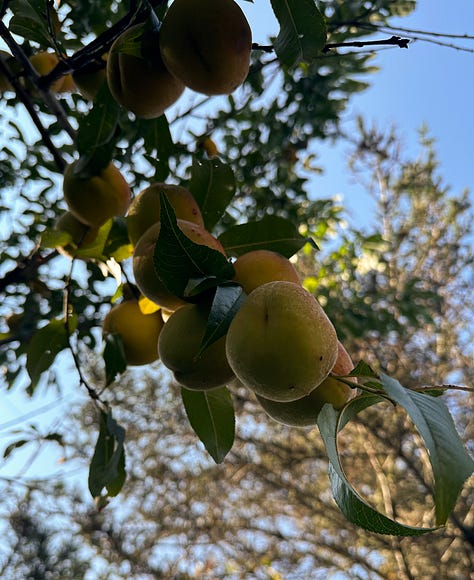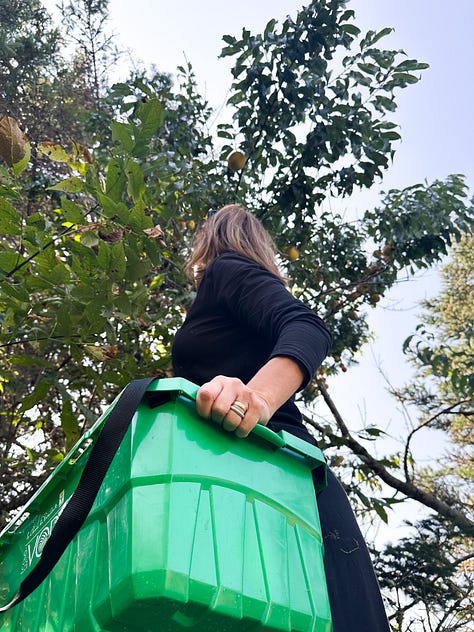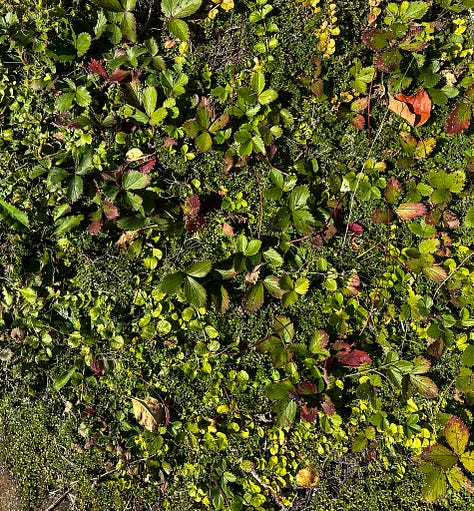I’ve been writing morning pages these past few days. It’s a practice that Julia Cameron teaches in her 1992 book The Artist’s Way. My Aunt Sandra gave me the book in August, 2001, when I was living in England. I know the date because I have a card from Sandra tucked inside its pages. One side of the card is a folk art painting of a blue ocean with a red fishing boat chugging through the water. On the other side is Sandra’s handwriting streaming across the card widthwise telling me about her summer, settling into her routine in the studio stiching a story onto cloth, how it’s exciting to begin and how hard it is to start. Her words are like a stream of consciousness, a window into her work and a taste of her morning pages.
I heard Julia Cameron’s morning pages mentioned three times from three different sources last week. I took it as a sign. I pulled out my dollar store journal and started writing. My green pen felt wild and looping on the giant page, so that’s how I began.
Wow my letters are wild and loopy. I forget how to write in cursive.
Three pages seems like a lot.
But it feels free and loose.
I’ll keep going.
Morning pages aren’t meant to be precious. Cameron describes them as “three pages of longhand writing about anything that crosses your mind, from the petty to the profound… It's like taking a little broom and sweeping all the debris in your life into the middle of the room so you can do something about it.”1 And as time passes, we begin to notice what comes up, what shifts, and what we've learned about ourselves. Yesterday I learned that I wanted to zone in tightly on blueberries - their dusty skins, blue and powdery, patterned like tiny globes. I learned that I was tired. That my back hurt while sitting. That I was grateful for the sun. That I didn’t know what this week’s newsletter would be about. Wait. Why not write about last Sunday, when my friend Jill and I picked peaches from her parents’ tree in Wentworth. Even though I’ve covered peaches for the past few weeks. Even though people might be tired of them. That’s what I want to sweep into the middle of the room.
The house is a winter house, tall, square and clad in shiplap. A red Adirondack chair made from old skis sits by the side door under a chalkboard where Jill’s mother’s cell number is scrawled in chalk. Beside it there’s a note that reads gone skiing. Further along the house where the roof overhangs the pathway, an icicle will form in winter. By the end of March it’s a mammoth’s trunk- thick and textured from cold mornings and sun soaked afternoons. There will be a cast iron bird feeder for the chickadees standing in the snow and a walkway weathered and worn under the weight of ski boots clomping towards the ski hill. This is how I know the house. Wintry.
Today we step from the car onto a padding of mossy thyme laced with wild strawberry vines lining the driveway. A sweet summery smell on this late September afternoon. Curtains are pulled across the windows. Someone has mowed the grass; it’s trim and green where the snow will be this winter. Along the edge of the property are pines, hemlocks and a towering spruce. Tucked inside the evergreens are two trees I hadn’t noticed in the winter - a gnarled apple tree with wizened fruit hanging from its branches and a tall, leafy peach tree stretching into the pine. They hide in winter, bare branches against the snow.
Jill gets a ladder from the shed and carries it across the grass. It’s dripping in feathers and fluff - a mouse had nestled in the rungs over the summer. She snaps it open, practical and efficient, and climbs up into the peach tree. Her summer job as a teenager was teaching kids how to sail. While I made chocolate milk with the kids I babysat, she rigged boats and tied clove hitches, reef knots and bowlines. There’s an efficiency to this woman, a promise that things will get done. I pass Jill her grocery basket from the back of her car and she drops the heavy peaches inside. She stretches and pulls at the branches to get the far away plump peaches. Shards of sunshine cut through the branches, barely making it through the pine up above. Jill climbs down the ladder and calls her dad to tell him we’ve completed the mission. There are just a few peaches left, beyond the reach from the top rung of the ladder, she says. He tells her to shake the tree, that’ll release the rest. I have been useless until this point. My back is sore, I am afraid of heights. But I can shake a tree. In the Artist’s Way Cameron writes that art comes from pain. We belt out Steve Miller: we really love those peaches, we want to shake that tree. A few peaches fall to the ground. I scoop them up and we head home.
A few weeks ago I made a peach pie with Violet Bakery’s lard pastry. Last week I made Sally Frawley’s peach and tomato salad. Then it was flavourfull.ca’s Pumble Bars with a few peaches thrown in. Three times a charm? I still have lots of peaches left, who knows what will happen next. I’ll write about tomorrow, or the next day, in my morning pages.



I loved hearing Julia Cameron’s calm, knowing voice in conversation with Elizabeth Gilbert on the How To Academy Podcast, recorded in 2022. You can listen to the episode here.





So many of us know of morning pages. ‘The Artist’s Way’ was such a cool way to get to know yourself. I love your use of it here. And no, I’m not tired of peaches yet. Down here in Australia, we have yet another blustery spring day that aggravates the insides. This too shall pass. The peach tree is moving from blossoms to greenery so not too long before I can eat peaches again. Hugs from afar. 🤗🤗💕
I’m there for the peaches🧡
I served the tomato/ peach salad at our family dinner last Sunday.. it was such a hit!
Recipes went out to all!
Morning pages.. I’d like to try that x